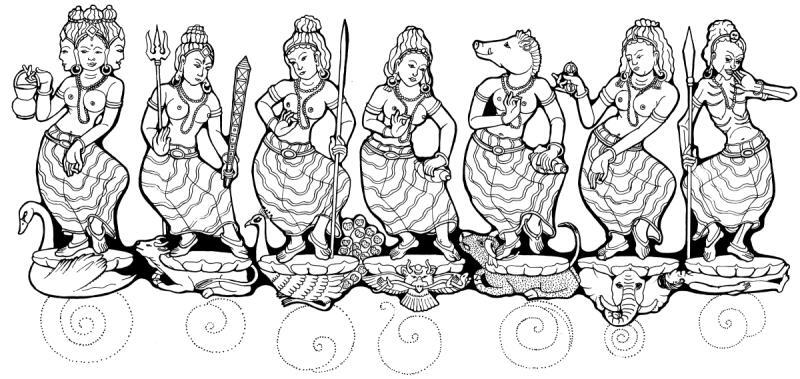The fourth chapter of A Garland of Forgotten Goddesses, is written by Shaman Hatley and concerns the Seven Mothers (sapta mātaraḥ), a fascinating group who represent the feminine sides of seven classically male Hindu gods whose purpose is to destroy troublesome demons and protect the righteous.

Hatley translates two passages that narrate the origin stories of the Mothers. The first is from the original Skanda Purāṇa, and dates to sixth or seventh century. The latter and longer story translated is from the Devī Purāṇa, from a century or two later.
The following snippet is from Hatley’s translation of the Skanda Purāṇa tale.
“Bowing in respect to Lord Śiva once again, the deities then said the following: ‘O god, create a beautiful female body of your own as well; together with her we will forcibly slay the demons, O supreme lord!’ The god then created the goddess Māheśvarī, an auspicious Mother, and also, resorting to a deformed appearance, a second Mother—Bahumāṃsā (‘Very Fleshy’) by name, the embodiment of universal destruction.”
“By the command of the God of gods, afterward the lord Viṣṇu also created two Mothers: Vārāhī as well as Vaiṣṇavī. From grandfather Brahmā came Brāhmī, and from Śiva, Māheśvarī. Kaumārī came from six-faced Kumāra, and Vaiṣṇavī from Viṣṇu. The goddess Vārāhī came from Viṣṇu, and Indrāṇī from the great Indra, the destroyer of cities. Possessing all powers, the auspicious goddess Bahumāmsā, most excellent of the Mothers, the Great Spell (mahāvidyā), came into being from the god Śiva, who has the bull as his standard.”
And here is a short excerpt from Hatley’s translation of the Devī Purāṇa telling:
“Beholding the battle of Brahmānī with the demons, Śiva also contemplated the supreme śakti for the purpose of creation. ‘Mutually protecting each other, they will do battle and conquer’—thinking thus, the lord of the gods created Māheśvarī, his own female embodiment. He first contemplated the goddess situated in the lotus of his heart, purely radiant like a hundred moons, mounted on a broad-shouldered bull bearing a trident and skull-staff. She shone brightly and her speech was grim: ‘Slay! Seize! Chop up!’ All the enemies fled after seeing her, sick with fear.”
—A Garland of Forgotten Goddesses, UC Press 2021